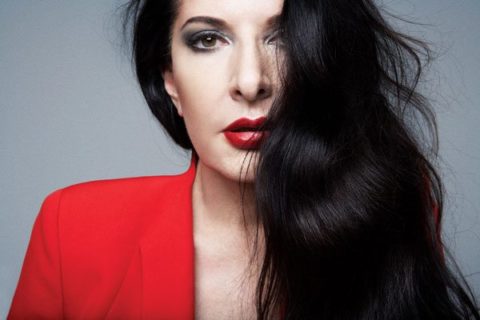Marina Abramović: The high priestess of performance art talks Givenchy, opera and her upcoming Luminato showcase


Few can claim to embody the term “masterclass” the way Marina Abramović can. The Serbian-born, New York-based performance artist has consistently risked her physical and mental health in order to examine the concept of human limitation. In 1974, for a piece called Rhythm 5, Abramović set fire to a large petroleum-soaked pentacle and lay expressionless in the centre of the star as the flames went up (she fainted from a lack of oxygen). Other extreme works—some of which are covered in 2012’s acclaimed documentary on her life, Marina Abramović: The Artist Is Present—had Abramović dripping candle wax on her bare skin, masturbating in public, cleaning human skulls and offering her naked body to strangers, who were encouraged to dress and undress her. One of her most time-consuming pieces—a 1988 performance titled The Lovers—had Abramović walk the east side of the Great Wall of China alone. The trip, which measured more than 2,000 kilometres, was planned alongside a parallel expedition taken by her lover and partner, Ulay, who trekked up the wall’s west side so the two could meet in the middle. When the pair reunited—three months after their respective journeys began—Abramović chose the moment to tell him she was putting an end to their professional and personal relationship.
A few critics read the act as a mere gimmick, a grandiose gesture that would hook the media into creating some of the biggest boyfriend-dumping buzz in art history. Others applauded her emotional marathon and saw its place in Abramović’s powerful body of work. As part of the Luminato arts festival in Toronto, Abramović will be re-experiencing her epic walk on the Great Wall, along with a number of equally dramatic parts of her life, in a biographical opera directed by Robert Wilson called The Life and Death of Marina Abramović. Most people would be reluctant to revisit painful memories, but the 66-year-old artist says the opera does a good job of re-evaluating her past.
“The entire approach to my relationship with Ulay in Life and Death is comical,” she says via phone from her office in New York. “There is a very serious scene in the opera where I say, ‘Now we walked enough kilometres just to say goodbye,’ and [the actor who plays Ulay] looks at me and says, ‘This is insane! Why didn’t you just make a phone call?’ It’s really funny how the drama was turned into this funny slapstick thing. At the same time, it becomes more tragic.”
Abramović’s initial heartbreak with Ulay caused a fashion epiphany. “I was totally desperate when I came to the end of my relationship with him,” she confesses. “I felt like I was at the end of everything. By chance, I had to work in Paris and dropped into Yohji Yamamoto and bought a suit that changed my relationship to fashion completely. I came out of the shop feeling restored. I realized the right clothes can change your mood. They can give you something that’s a forbidden pleasure. This new interest ended up giving me emotions I didn’t know I could have.”
The experience led her to a long-lasting friendship with Givenchy creative director Riccardo Tisci, with whom she now shares a New York townhouse. They famously posed in a portrait together in which Abramović breastfeeds Tisci in mock “Madonna and child” poses. Tisci also cast his “soul mate” in Givenchy’s spring campaign alongside models Kate Moss and Mariacarla Boscono. “Some designers are artists in their own right, and he is one of them,” Abramović says of Tisci. “I love that he would think of me. Fashion campaigns are what you are supposed to do when you are 18,” she says with a laugh. “I’m never doing things when I’m supposed to.”
Abramović’s co-operation with the house is something that she would never have considered in the ’70s, when she started to make video works such as Art Must Be Beautiful, Artist Must Be Beautiful. Filmed like a Vidal Sassoon ad from the disco era, the work attacks mainstream associations pertaining to beauty, decor and fashion. “Back then, I was fed up with the idea that art had to be beautiful and that paintings had to match the carpets of living rooms,” she says. “So I took a metal brush and literally tried to destroy my face and my hair, just to create an opposite image: that art not only has to not be beautiful—it has to be disturbing.”
Her newfound fascination with musical theatre is not without its complexities either. Claiming that opera “in general” is “a dinosaur: it’s very old and needs a progressive facelift,” Abramović says her Luminato production—which features Oscar-nominated actor Willem Dafoe and singer Antony Hegarty—took some time to get to. “I couldn’t have done this 20 years ago. As you get older, you understand risk more and you understand danger more. With age your mind becomes so much more trained, so you actually push much harder when it comes to work.”
The Life and Death of Marina Abramović’s libretto also recreates various incidents from her thorny upbringing in the former Yugoslavia, supervised by two national war heroes—her father, a former commander, and her mother, a former major. “‘Supervised’ is the perfect word to use. I had a really difficult relationship with my mother,” she says, noting that she will be playing herself and her mother in the Toronto production. “The last thing I would think of is seeing her [on stage with me], but her presence in this work ended up being a self-portrait.”
As for opera’s legendary damned ladies—the prima donna singers who have fronted the genre for years—Abramović says she has nothing in common with them. “I never feel like I’m forever failing…or broken, like Maria Callas or any of the grand divas,” she says. “My spirit is very much like a strong steed. Opera does not close any doors in my life—it just opens more.”







